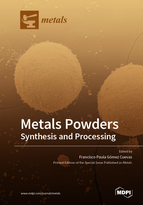Metals Powders: Synthesis and Processing
A special issue of Metals (ISSN 2075-4701).
Deadline for manuscript submissions: closed (30 November 2019) | Viewed by 50491
Special Issue Editor
Interests: powder metallurgy; mechanical alloying; sintering; field assisted sintering; amorphous materials; effective properties of porous materials; modeling of effective properties
Special Issues, Collections and Topics in MDPI journals
Special Issue Information
Dear Colleagues,
Metallic parts can be obtained with a wide variety of techniques. One of these techniques, traditionally known as powder metallurgy, uses powders as the starting material, which are processed to obtain the final product. In this Special Issue of Metals, we are interested in providing a general picture of the latest developments of two aspects related with metal powders: synthesis and processing.
Powder synthesis through mechanical alloying, atomization, evaporation–condensation, electrochemical reduction processes, phase separation, etc., leads to different purities, alloy composition limits, particle sizes, shapes, and microstructures. This allows a wide variety of metal powders, not only regarding composition but also properties. These powders can then be processed through traditional press and sinter powder metallurgy techniques, hot isostatic pressing, injection molding, field-assisted electrical sintering techniques, thermal spray or additive manufacturing techniques, among others, leading to quite different final products.
Articles and reviews on advances in known synthesis and processing technologies, as well as new developments in these research fields, both from academic and industrial researchers are welcome in this Special Issue.
Prof. Francisco Paula Gómez Cuevas
Guest Editor
Manuscript Submission Information
Manuscripts should be submitted online at www.mdpi.com by registering and logging in to this website. Once you are registered, click here to go to the submission form. Manuscripts can be submitted until the deadline. All submissions that pass pre-check are peer-reviewed. Accepted papers will be published continuously in the journal (as soon as accepted) and will be listed together on the special issue website. Research articles, review articles as well as short communications are invited. For planned papers, a title and short abstract (about 100 words) can be sent to the Editorial Office for announcement on this website.
Submitted manuscripts should not have been published previously, nor be under consideration for publication elsewhere (except conference proceedings papers). All manuscripts are thoroughly refereed through a single-blind peer-review process. A guide for authors and other relevant information for submission of manuscripts is available on the Instructions for Authors page. Metals is an international peer-reviewed open access monthly journal published by MDPI.
Please visit the Instructions for Authors page before submitting a manuscript. The Article Processing Charge (APC) for publication in this open access journal is 2600 CHF (Swiss Francs). Submitted papers should be well formatted and use good English. Authors may use MDPI's English editing service prior to publication or during author revisions.
Keywords
- Powder synthesis
- Mechanical alloying
- Atomization
- Metal oxide reduction
- Nanopowders
- Powder metallurgy
- Metal injection moulding
- Field assisted sintering
- Additive manufacturing
Benefits of Publishing in a Special Issue
- Ease of navigation: Grouping papers by topic helps scholars navigate broad scope journals more efficiently.
- Greater discoverability: Special Issues support the reach and impact of scientific research. Articles in Special Issues are more discoverable and cited more frequently.
- Expansion of research network: Special Issues facilitate connections among authors, fostering scientific collaborations.
- External promotion: Articles in Special Issues are often promoted through the journal's social media, increasing their visibility.
- Reprint: MDPI Books provides the opportunity to republish successful Special Issues in book format, both online and in print.
Further information on MDPI's Special Issue policies can be found here.






